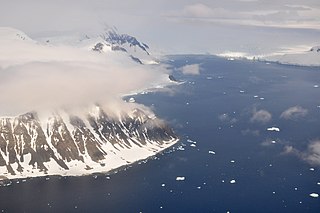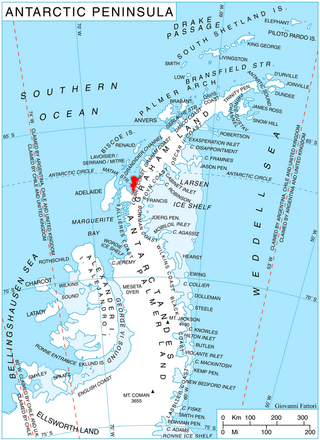Related Research Articles

Koettlitz Glacier is a large Antarctic glacier lying west of Mount Morning and Mount Discovery in the Royal Society Range, flowing from the vicinity of Mount Cocks northeastward between Brown Peninsula and the mainland into the ice shelf of McMurdo Sound.

The Fallières Coast is that portion of the west coast of the Antarctic Peninsula between the head of Bourgeois Fjord and Cape Jeremy and lies on Marguerite Bay and the Wordie Ice Shelf. On the south it is joined by Rymill Coast, and in the north by Loubet Coast. Fallières Coast was first explored in January 1909 by the French Antarctic Expedition under J.B. Charcot, who named it for Armand Fallières, then President of France.

Arrowsmith Peninsula is a cape about 40 miles (64 km) long on the west coast of Graham Land, west of Forel Glacier, Sharp Glacier and Lallemand Fjord, and northwest of Bourgeois Fjord, with Hanusse Bay lying to the northwest. It was surveyed by the Falkland Islands Dependencies Survey (FIDS) in 1955-58 and named for Edwin Porter Arrowsmith, Governor of the Falkland Islands.

Wright Peninsula is a peninsula on the east coast of Adelaide Island, Antarctica, lying between Stonehouse Bay to the north and Ryder Bay to the south. On its northern coastline the peninsula is fringed by the Stokes Peaks; on its southern side by the Reptile Ridge. The Princess Royal Range separates the peninsula from the rest of Adelaide Island; the only 'gap' is provided by McCallum Pass.
Breidnes Peninsula is a rocky peninsula, 13 nautical miles (24 km) long and 5 nautical miles (9 km) wide, between Ellis Fjord and Langnes Fjord in the Vestfold Hills. It was mapped by Norwegian cartographers from air photos taken by the Lars Christensen Expedition (1936–37) and named "Breidneset".
Weddell Arm is the southernmost and westernmost arm of Langnes Fjord in the Vestfold Hills. Mapped by Norwegian cartographers from air photos taken by the Lars Christensen Expedition, 1936–37. Visited in 1955 and 1957 by ANARE parties and so named because they found large numbers of Weddell seals in the area.
Krok Fjord is a narrow sinuous fjord, 11 nautical miles (20 km) long, between Mule Peninsula and Sorsdal Glacier Tongue, at the south end of the Vestfold Hills, Antarctica. It was mapped from air photos taken by the Lars Christensen Expedition (1936–37) and named "Krokfjorden".

Guerrero Glacier is a glacier about 7 nautical miles (13 km) long in Doyran Heights, draining from the southeast slopes of Mount Havener southwest of Beloslav Peak to the south side of Taylor Spur, in the southeast part of the Sentinel Range, Ellsworth Mountains, Antarctica. It was first mapped by the United States Geological Survey from surveys and U.S. Navy air photos, 1957–59, and was named by the Advisory Committee on Antarctic Names for John F. Guerrero, a meteorologist at South Pole Station in 1957.
Tryne Crossing is a low but rough pass across Langnes Peninsula, Vestfold Hills, leading from the southwest arm of Tryne Fjord to Langnes Fjord. Used for portage and sledges and probably suitable for tracked vehicles. The area was mapped from air photos taken by the Lars Christensen Expedition (1936–37), and was photographed by U.S. Navy Operation Highjump (1946–47). First traversed by an ANARE party led by B.H. Stinear, May 13, 1957, and named for its association with Tryne Fjord.
Tryne Fjord is an irregular-shaped fjord that idents the northern side of Langnes Peninsula in the Vestfold Hills. Mapped and named Tryne Fjord by the Lars Christensen Expedition, 1936–37. Barrier Island lies at the entrance to the fjord.
Tryne Sound is a short, narrow passage on the north side of Langnes Peninsula, Vestfold Hills, connecting Tryne Bay and Tryne Fjord. Mapped by Norwegian cartographers from air photos taken by the Lars Christensen Expedition (1936–37) and named Tryne Sund.
Ellis Fjord is a long narrow fjord between Breidnes Peninsula and Mule Peninsula in the Vestfold Hills of Antarctica. It was photographed by the Lars Christensen Expedition (1936–37), and plotted by Norwegian cartographers as a bay and a remnant lake which were called "Mulvik" and "Langevatnet" respectively. Analysis by John Roscoe of air photos taken by U.S. Navy Operation Highjump (1946–47) showed these two features to be connected. The feature was renamed Ellis Fjord by Roscoe after Edwin E. Ellis, aerial photographer on U.S. Navy Operation Highjump flights over this area.

Field Glacier is a glacier on Pernik Peninsula, Loubet Coast in Graham Land, situated south of Salmon Cove, and flowing west into Lallemand Fjord just south of Kanchov Peak. It was mapped from air photos taken by the Falkland Islands and Dependencies Aerial Survey Expedition, 1956–57. In association with the names of glaciologists grouped in this area, it was named by the UK Antarctic Place-Names Committee after William B.O. Field, an American glaciologist and surveyor, sometime Research Fellow of the American Geographical Society.

Sölch Glacier is a glacier on the Pernik Peninsula of the Loubet Coast in Graham Land, flowing west to Salmon Cove just north of Kanchov Peak on the east side of Lallemand Fjord. It was mapped from air photos taken by the Falkland Islands and Dependencies Aerial Survey Expedition, 1956–57, and named by United Kingdom Antarctic Place-Names Committee for Johann Sölch (1883–1951), an Austrian glacial geologist and glaciologist.
Taynaya Bay is a bay which is completely enclosed except for a very narrow entrance on the north side, lying within the northern part of Langnes Peninsula, Vestfold Hills. The feature was photographed by the Lars Christensen Expedition (1936–37), but was plotted on the subsequent maps as a lake. John Roscoe's 1952 study of air photographs taken by Operation Highjump (1946–47) showed that the bay is connected at the north to the sea. It was photographed by ANARE (1954–58) and the Soviet Antarctic Expedition (1956), the latter applying the name Bukhta Taynaya.
Topografov Island is an island just north of Partizan Island in the north part of the entrance to Langnes Fjord, Vestfold Hills in Antarctica. Mapped by Norwegian cartographers from air photos taken by the Lars Christensen Expedition (1936–37). Subsequently, photographed by U.S. Navy Operation Highjump (1946–47), ANARE (1954–58) and the Soviet Antarctic Expedition (1956). The latter named it Ostrov Topografov.
Luncke Ridge is a fairly prominent ridge on the northern side of the eastern extremity of Langnes Fjord in the Vestfold Hills of Antarctica. It was mapped by Norwegian cartographers from air photos taken by the Lars Christensen Expedition, 1936–37. The ridge was seen in 1957 by an Australian National Antarctic Research Expeditions party and named for Bernhard Luncke, a Norwegian cartographer who plotted the Vestfold Hills area for the Hansen Atlas.
Venus Glacier is a glacier on the east coast of Alexander Island, Antarctica, 10 nautical miles (18 km) long and 6 nautical miles (11 km) wide at its mouth flowing east into George VI Sound lying between Keystone Cliffs and Triton Point. The coast in this vicinity was first seen from the air by Lincoln Ellsworth on November 23, 1935 and roughly mapped from photos obtained on that flight by W.L.G. Joerg. The glacier was first surveyed in 1949 by the Falkland Islands Dependencies Survey and named by the United Kingdom Antarctic Place-Names Committee for the planet Venus, the second planet of the Solar System.
Vallot Glacier is a glacier flowing northwest to Laubeuf Fjord close south of Lewis Peaks, on Arrowsmith Peninsula in Graham Land. It was mapped by the Falkland Islands Dependencies Survey (FIDS) from surveys and air photos, 1948–59, and was named by the United Kingdom Antarctic Place-Names Committee (UK-APC) for Joseph Vallot, a French naturalist and glaciologist who first measured the surface velocity of a glacier over a long period, in Switzerland, 1891–99.
Langnes Peninsula is a narrow rocky peninsula in Antarctica. Of irregular shape, and 9 nautical miles (17 km) long, it is the northernmost of the three main peninsulas that comprise the Vestfold Hills. The name derives from "Langneset", applied by the Lars Christensen Expedition (1936–37) which mapped the peninsula from aerial photographs.
References
- ↑ "Langnes Fjord". Geographic Names Information System . United States Geological Survey, United States Department of the Interior . Retrieved 2013-05-29.
![]() This article incorporates public domain material from "Langnes Fjord". Geographic Names Information System . United States Geological Survey.
This article incorporates public domain material from "Langnes Fjord". Geographic Names Information System . United States Geological Survey.